Running an online WooCommerce store isn’t a cakewalk.
It involves tackling multiple challenges like setting up the website, managing the products, taking care of the hosting, executing marketing strategies, analyzing trends, making informed decisions, building customer relationships, and so much more.
Now, what if you had to manage not one but multiple WooCommerce stores?
The challenges just skyrocket to 10X. Don’t they?
Well, many entrepreneurs running WooCommerce multiple stores live this horror every day.
They juggle with:
- Admin work
- Marketing
- Customer support
- Reporting
- Decision making and strategizing
- Order and user management
The list is endless….

So, how do these WooCommerce multistore businesses survive?
The answer is simple – They pick the right tools to get the work done.
In this article, we will chalk out some tools that will help you preserve your sanity as you manage your WooCommerce multistore setup. So hang in there…
What is WooCommerce’s multi-store functionality?
As your business grows, you might find the need to set up multiple WooCommerce stores.
This is where the WooCommerce multi-store functionality comes into play, allowing you to create and manage multiple online stores using just one WooCommerce setup and database.
Think of yourself as the captain of a ship and each of your crew members as an online store.
Each crew member has unique responsibilities, but they all work together under your command to steer the ship in the right direction.
Similarly, the WooCommerce multi-store feature helps you manage all your stores through a central WooCommerce setup.
Understanding the WooCommerce multistore environment
Before going full blast in multi-store jargon, let’s touch upon “why do people have multiple stores?” especially when running even a single store is stressful.
There are two main reasons:
- Different product lines: – Many entrepreneurs run multiple businesses at once. They have products, services, and tend to have a separate website to promote each of their ventures.
- Sold in different countries: – At times, they have the same product, but since it is sold in various countries, they create separate WooCommerce stores and personalize the product based on the country’s language, currency, sentiments, preferences, etc.
Regardless of the reasons, they ultimately have to manage more than one WooCommerce store. And that’s where the real cha
But don’t worry, we have a breakthrough solution, and we will reveal it towards the end of the article. Stay tuned.ned.
Coming back to the right tools for managing multiple WooCommerce shops;
Here is a quick video you must watch:
Why consider creating a WooCommerce multistore setup?
It is important to determine your “why” before jumping into the process of establishing the WooCommerce multistore.
Together, let’s explore the reasons why you need to create multiple stores using WooCommerce.
Reason #1: Selling Overseas
Expanding your business overseas is the top reason for creating multiple stores.
With a WooCommerce store, you can cater to a specific country by creating a store in a different language, offering certain products, or customizing products.
Additionally, you can accept various currencies.
Reason #2: Unique Storefronts for Different Products
If you have a diverse range of products, creating unique storefronts can help you better target your audience and improve your SEO efforts.
For example, if you sell both t-shirts and shoes, creating a separate shoe store can be beneficial.
Reason #3: Connecting Multiple WooCommerce Stores
If you run several online stores using WooCommerce, connecting them all allows you to manage them from one central location.
It’s like having multiple stores in different cities, but you can control them all from your headquarters.
Reason #4: Keeping Track of Everything, Everywhere
With product data, inventory, and orders synced across all your online stores, you have eyes everywhere in your business.
This provides you with real-time insight that can help you make informed decisions and stay on top of your operations.
Reason #5: Quickly Get and Analyze All Sales Data
Using multisite, you can export all your sales data from one store or all stores simultaneously.
This makes managing and analyzing your sales easier because you have all the information in one place.
The WooCommerce multistore option allows you to run countless websites from one network, making admin tasks easier with everything in one place.
What are the challenges of managing multiple stores?
It is also important to know what challenges you might face while running WooCommerce multiple stores. This lets you stay prepared to resolve quickly when they arise. These challenges are:res.
- Managing Complexity: Setting up a multisite can be complex, requiring a deep understanding of WooCommerce and its capabilities.
- Plugin Compatibility: Not all plugins work seamlessly in a multisite environment, requiring thorough testing to ensure compatibility.
- Security Concerns: Despite operating independently, stores share a common database, posing potential security risks.
- Customization Challenges: Implementing store-specific customizations without affecting others demands technical expertise.
- Hosting Requirements: Running multiple stores from one installation demands significant server resources and robust hosting solutions.
With the right help and preparation, you can overcome these challenges and make the most of WooCommerce’s multi-store capabilities.
Steps to setup a WooCommerce multi-store network
If you’re planning to create multiple stores using WooCommerce, it’s important to have a good understanding of the process.
One of the best ways to learn is through a visual tutorial. We recommend an insightful video by Brian from AovUP. Brian has been working in the field since 2008 and provides an in-depth, step-by-step guide to setting up a multisite and optimizing it for WooCommerce.
So, why wait? Watch his video below to learn the process.
Now, let’s discuss the WooCommerce multistore plugins that can ease WooMultistore management.
Plugins that help manage multistore WooCommerce. Effortlessly.
You can find a range of WooCommerce multistore plugins to manage multiple stores with ease. Let us introduce you to some of the most impactful ones available.
Handling Cart and checkout across multiple WooCommerce stores – WooCommerce Global Cart
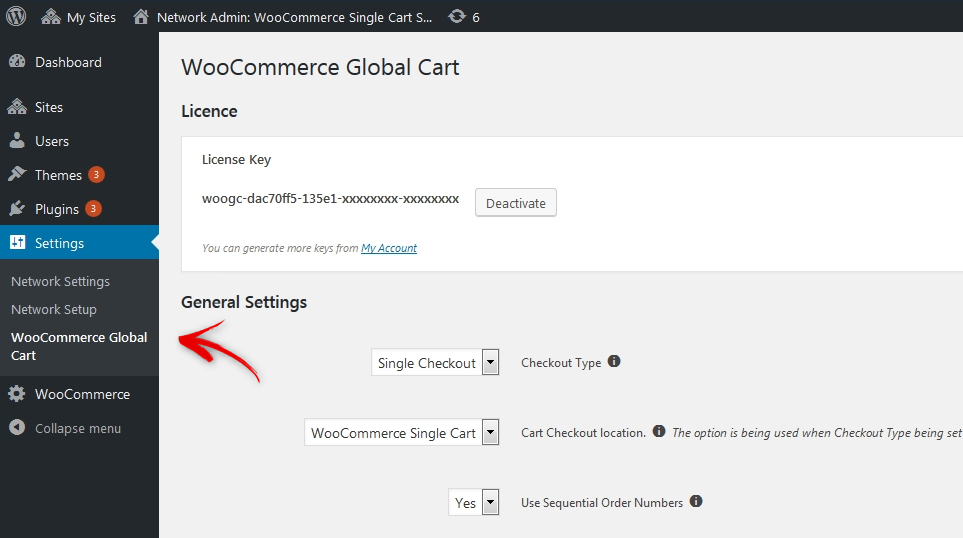
The WooCommerce Global Cart plugin helps you bring all your stores together to form a marketplace with a single cart and checkout. So your customers can add any product from any store to the cart.
The plugin integrates flawlessly with all the shops running in the multisite environment. It works with all domain types, including custom domains, subdomains, and subfolders. Overall, the single cart setup is simpler for customers, and they can access all the stores with the same user account.
Benefits of WooCommerce Global Cart
- Flexible cart checkout
- WooCommerce global reports.
- Unique orders interface for easy management.
- Global search across all shops.
- Globally managed user data.
- Enhanced order processing.
Pricing: The pricing starts at $120 per y
Duplicating products across multiple WooCommerce stores – WooCommerce Multisite Duplicator

The WooCommerce Multisite Duplicator plugin helps you address one of the common issues you may face while creating multiple sites in the same environment.
When you set up multiple stores, you may need to copy products from one site to another. The WooCommerce multisite duplicator plugin helps you manage this pretty easily. This enables you to duplicate your set of products from one site to another site or all other sites in the network.
You can copy everything related to a product, including images, taxonomies, attributes, variations, and metadata.
Benefits of WooCommerce Multisite Duplicator
- Configure what store data you want to show, create custom store locator layouts & apply custom map stylings to adapt the design to your theme.
- Create unlimited store categories & filters.
- SKU and timely update products by title and slug.
- Display duplicate links in product lists and pages.
Price: It costs $49 per year.
WooCommerce Multisite Duplicator
Reporting and analyzing multiple WooCommerce shops – Putler
One major hassle of running multiple stores is monitoring each of them. You need to have eyes everywhere at all times.
So switching between your WooCommerce shops is not the solution.
Here’s where Putler comes in.
Putler is the go-to tool that helps you monitor, manage and grow all your multiple WooCommerce shops from a single place.

Benefits of using Putler
Connect unlimited WooCommerce shops to Putler
And no I’m not exaggerating. You can literally connect as many WooCommerce shops to Putler as you want and then monitor all those shops from a single window.
Well, the steps to connect a WooCommerce store to Putler is super simple:
- Once you sign in to Putler, click on the WooCommerce icon
- Fill in your WooCommerce shop URL.
- Log in to your WooCommerce account
- It will automatically install WooCommerce – Putler connector plugin on your WooCommerce site via FTP
Once connected with one WooCommerce store, you can go ahead and start adding the other WooCommerce stores.
Automatic data processing, deduping and reports
Once you have connected your multiple WooCommerce stores to Putler, it will automatically pull in the data, process it, remove duplicates, and show you combined reports of various types.
- Sales reports – Putler shows you in-depth reports on sales made in your store. It will show you a list of all the sales orders and invoices with every detail of the order, like transaction ID, customer names, product sold, and a lot more.
- Product reports – Not just sales; Putler gives reports on products too. It will list all the products from all your WooCommerce shops that are connected to Putler. It, then, will display product performance in an intuitive graph and table format. Each product will have an in-depth report that looks something like this.
- Customer reports – Putler analyses your customer data from all the connected WooCommerce shops. It conducts RFM analysis (Recency, Frequency, and Monetary) on each customer and divides customers into 11 segments, including loyal, hibernating, about to lose, etc. You can use these segments to send targeted marketing emails for enhanced customer engagement and retention.
Putler can also come in handy while looking up customer information. Instead of going to every WooCommerce shop admin and digging into customer data, simply search for the customers using the advanced filter in Putler and get all the information about the customers you ever needed – purchase history, client personal information, LTV, etc.
- Transaction reports – Similar to sales, Putler will show you every transaction made on all of your WooCommerce stores within seconds. You can look up the refunds, pending transactions, failed transactions, and completed ones. Everything. You can also write small notes and tags for future reference.

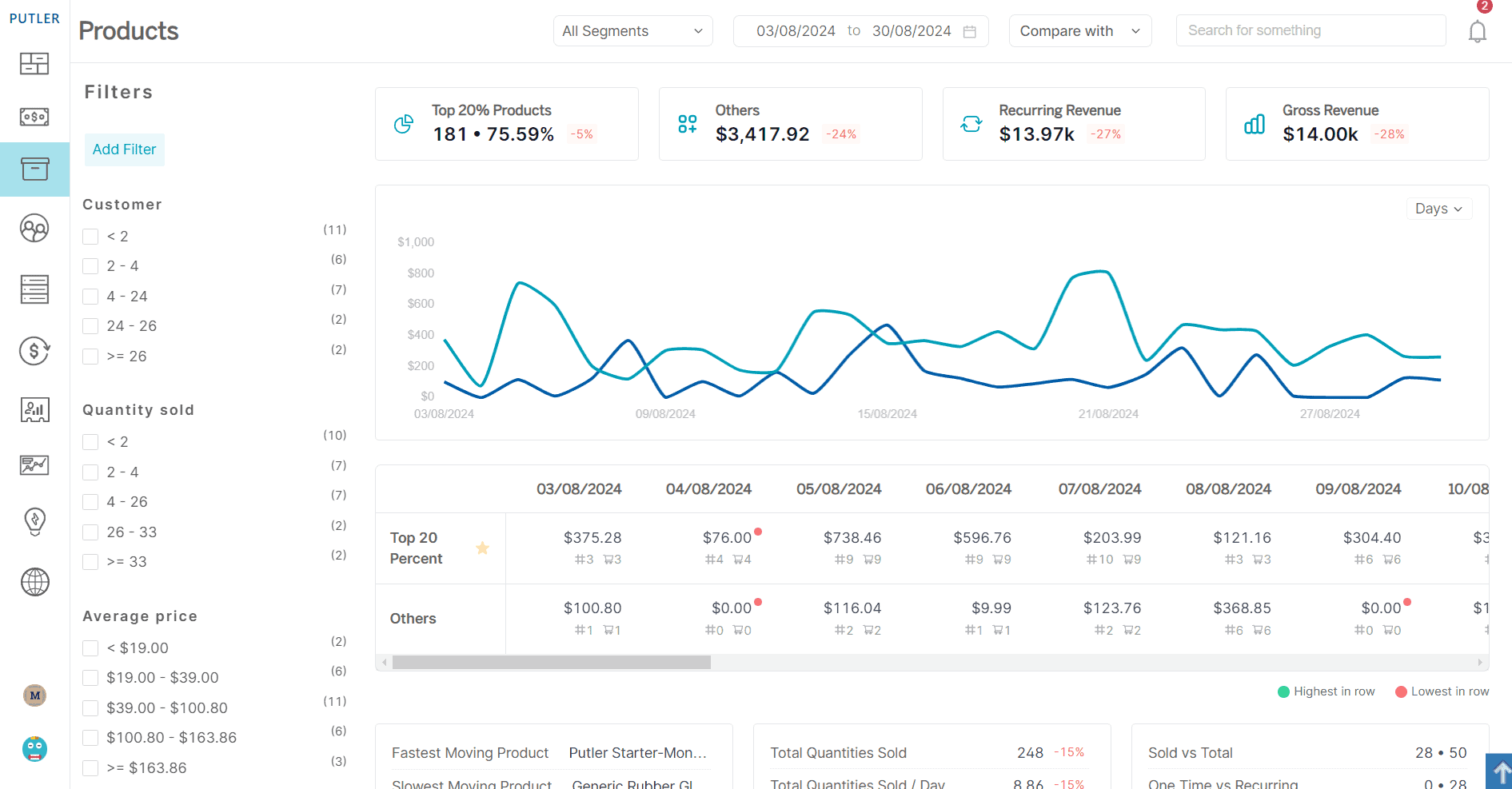
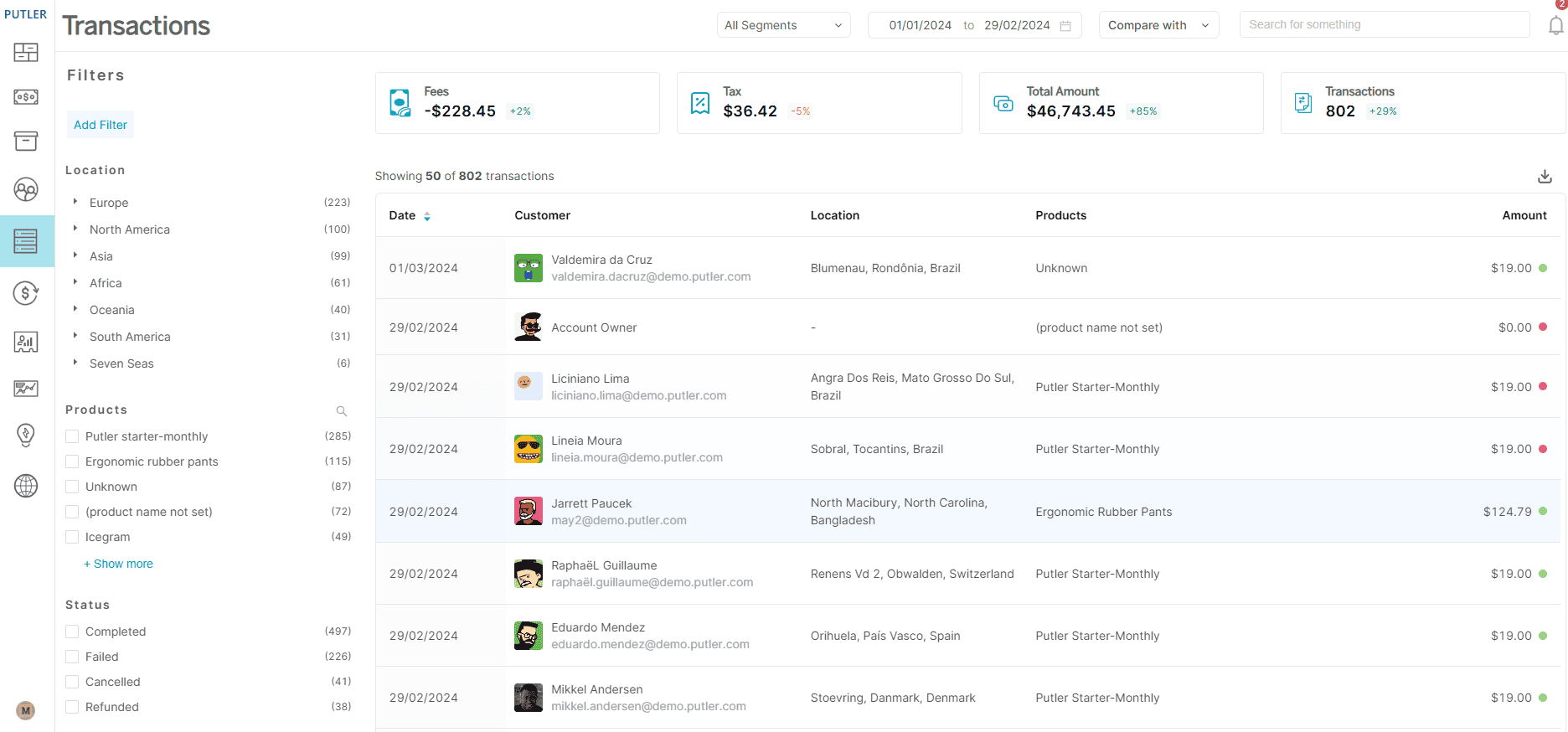
Activity view
This feature lets you view all your WooCommerce stores in a single place— the Putler dashboard. It gives you a minute-by-minute update on every transaction (sales and refunds) in all your stores.
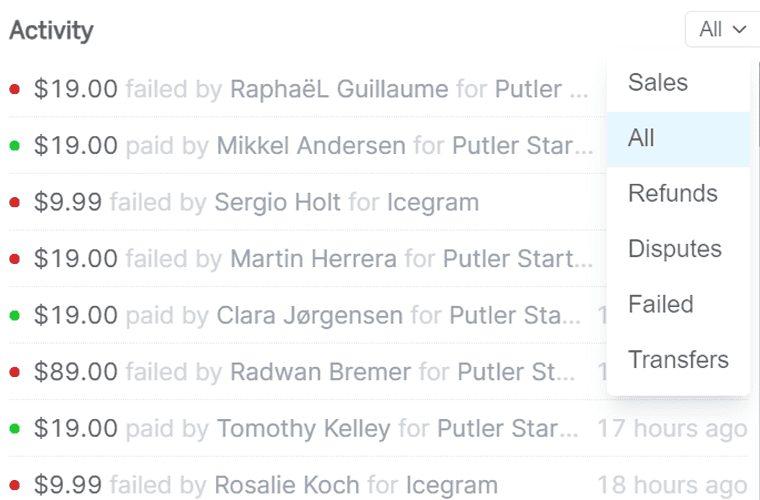
Weekly emails
As a store owner, you must regularly track the progress of your business. You probably spend a few hours each week collating data from all our multiple WooCommerce shops, exporting CSV files, carrying out Excel operations, and more.
Putler saves all those extra hours for you. Once you connect all your WooCommerce stores to Putler, it syncs all your store data at runtime, giving you up-to-date reports.
In addition, Putler also sends you and your team a weekly email with all your important statistics.
Team sharing
Just as weekly emails help you stay on top of your data, your team needs to stay updated too. Putler’s team-sharing feature makes this possible.
This feature allows you to invite as many team members to Putler and provide them access to only those stores that they are associated with. Also, choose between two roles, Admin and Support, so you decide on who can see what data.
Toggle between multiple stores
We understand viewing combined data is magical but at times, you might want to analyze WooCommerce stores individually, right?
Putler helps you with that as well.
You can easily create individual views of your WooCommerce stores and then toggle to see reports of a single WooCommerce store, also known as Strategic Business Unit (SBU) Reporting.
Over to you
I hope you found this guide on how to manage WooCommerce multistore useful. All the tools mentioned above have their own merits and make managing, monitoring multiple WooCommerce shops really simple. Do give them a try.
BTW, if you know of more tools that help with managing multiple shops on WooCommerce, comment below!
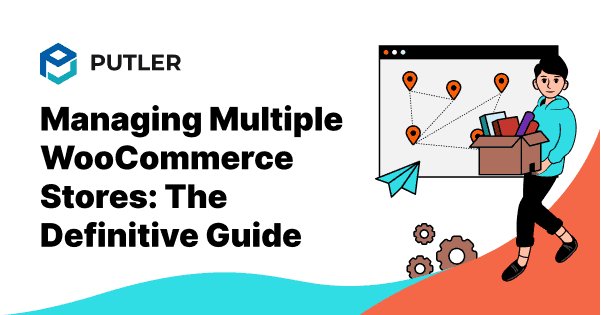
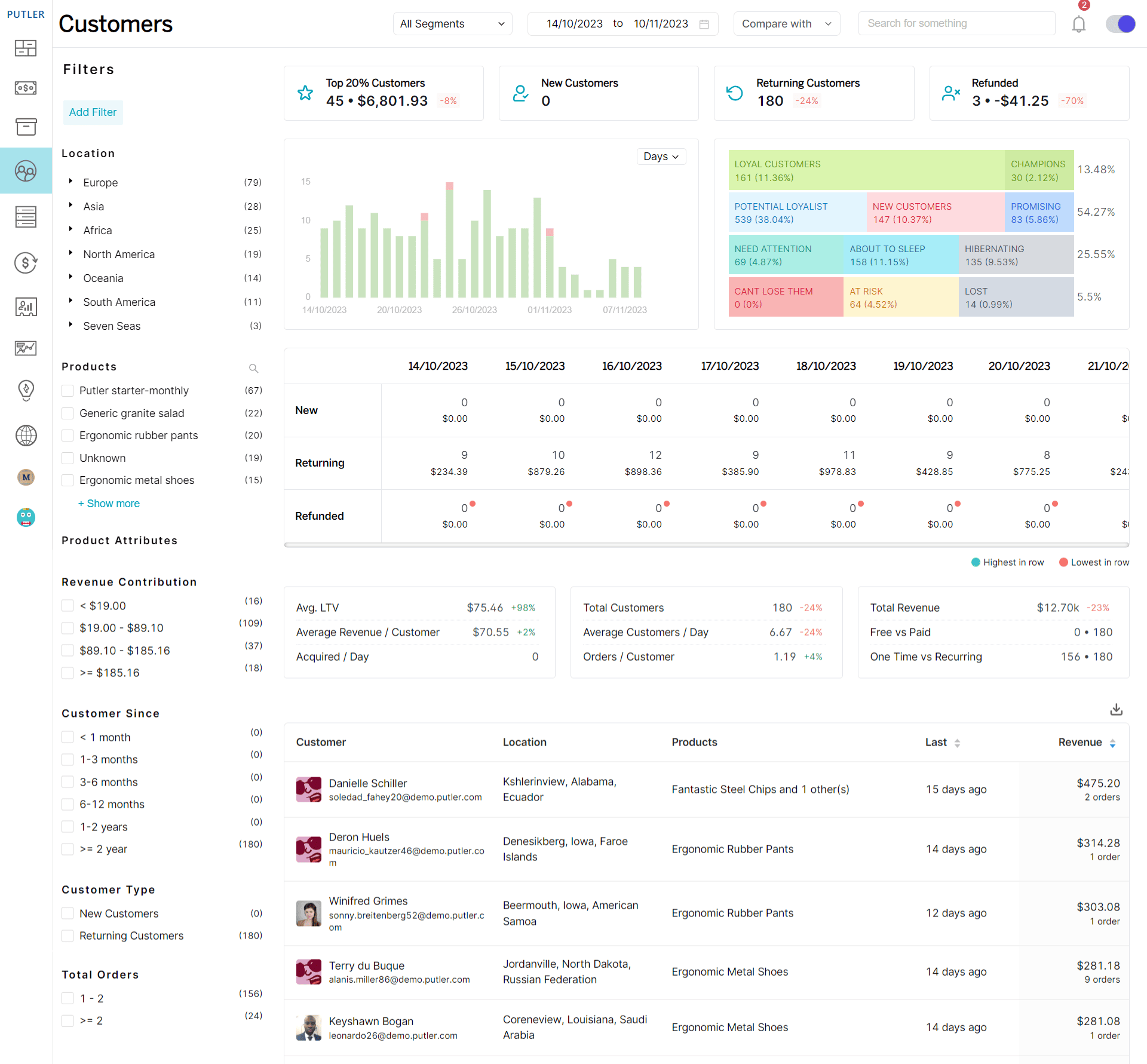
Sounds Good, definitely will give it a go when I’m online!
Thanks for the appreciation Joey. Do try out Putler and send us an email if you need any help.
Hello,
Hope you are doing well.
Being an experienced blogger, I am really impressed with the content you’re producing for your website